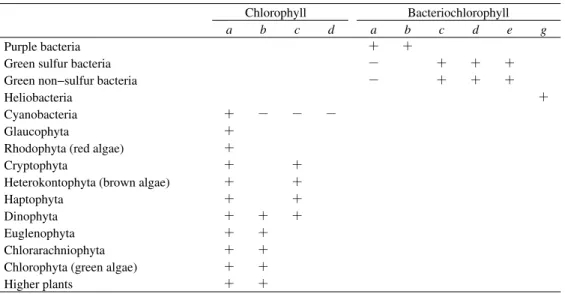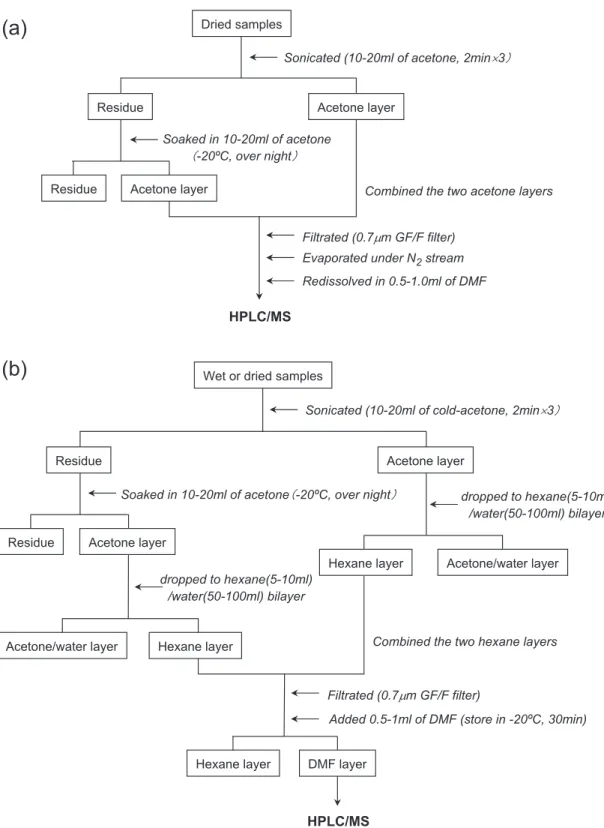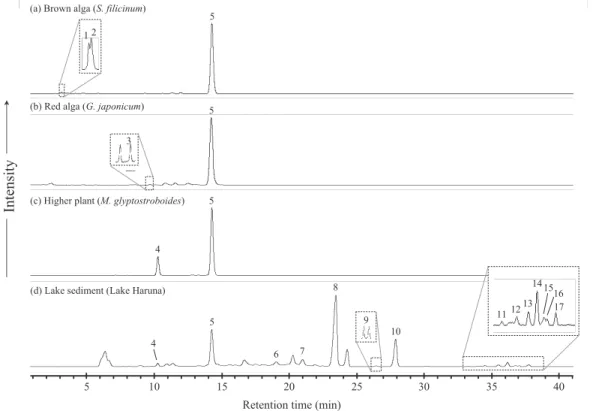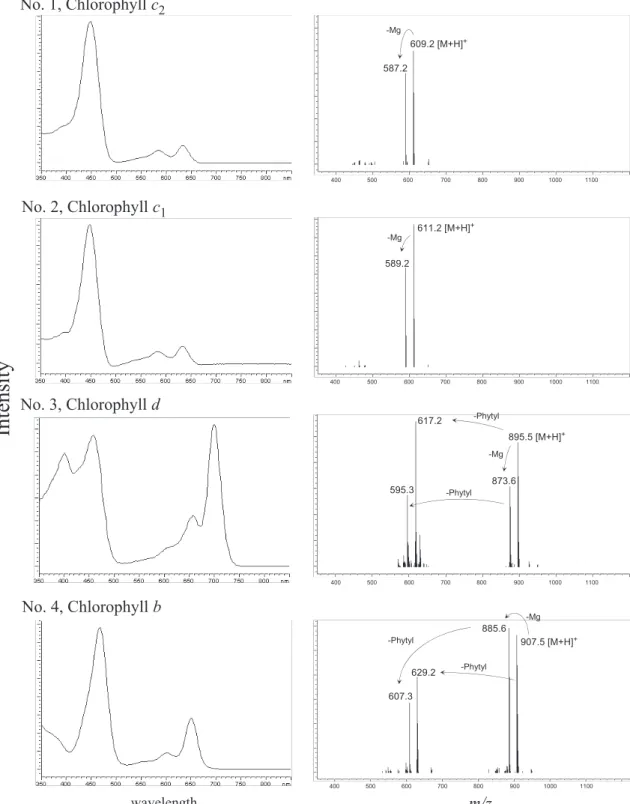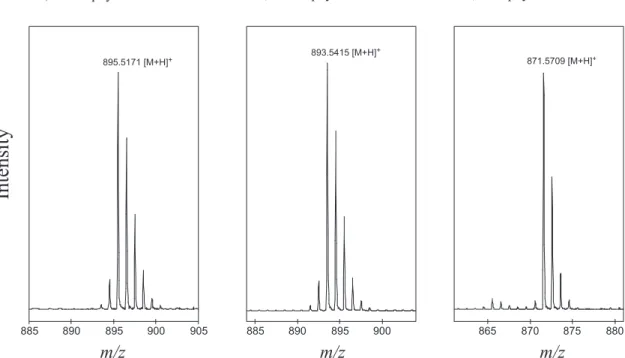1.はじめに クロロフィル・バクテリオクロロフィルなどの クロロ色素は,光合成生物のアンテナ色素であ り,また,クロロ色素及びその初期続成生成物で あるフェオ色素は,水柱や堆積物などの環境試料 中に普遍的に見いだされる。そのためこれらのク ロロ色素・フェオ色素は,光合成生物の最も確実 なバイオマーカーとして多くの研究で用いられて きた(例えば,Sanger, 1988; Keely et al., 1990; Airs et al., 2001; Nakajima et al., 2003)。クロロ色素には 構造の異なるものが数多く存在し,その構造は光 合成生物の進化・多様化と密接に関係している (Table 1,例えば,千原ら,1999; Delwiche, 1999; Tomitani et al., 1999; Blankenship, 2002; Grimm et
al., 2006)。また,クロロ色素の炭素・窒素・水素 同位体比は,起源となる光合成生物の生育環境の 情報を良く保存しており(例えば,Bidigare et al., 1991; Chikaraishi et al., 2005),とくに窒素同位体 比に関しては,窒素原子を含む良いバイオマー カーが他にないため,クロロ色素及びその分解生 成物(フェオ色素・アルキルポルフィリン・マレ イミドなど)の窒素同位体比は,過去の海洋・湖 沼の窒素サイクルの復元をするうえで,質の良い 情報を提供できるほとんど唯一の指標になる(例 えば,Ohkouchi et al., 2005, 2006)。 クロロ色素・フェオ色素の同位体比は,一般的 に,元素分析計/同位体比質量分析計(EA/IRMS)
で測定される(e.g. Chikaraishi et al., 2005)。一般的 な分析手順は,(1)試料からの抽出,(2)高速液 体クロマトグラフ(HPLC)による個々の色素分 子の分取(単離),(4)EA/IRMS による同位体比 の測定で構成される。本報では,藻類・植物葉・ 堆積物を例に,環境試料中に含まれるクロロ色 素・フェオ色素の分取・同位体比分析を念頭にお いた抽出法および高速液体クロマトグラフ/質量 分析計(HPLC/MS)による分析法(同定法)を紹 介する。 2.試 料 神奈川県湯河原町の相模湾沿岸で採取した褐藻 (シダモク,Sargassum filicinum )・紅藻(テング サ,Gelidium japonicum ),東京都八王子市で採取 した陸上植物の葉(メタセコイヤ,Metasequoia glyptostroboides),群馬県榛名町の榛名湖で採取し た湖底堆積物(30-40 cm)を用いた(試料の詳細 は,Chikaraishi et al., 2004, Chikaraishi and Naraoka,
2005; Chikaraishi, 2006などを参照していただきた い)。 3.分析方法 3.1.分析上の注意 生物試料や環境試料に含まれるクロロ色素・ フェオ色素は,一般に,アセトンなどの有機溶媒 により抽出され,逆相カラムを用いた HPLC また は HPLC/MS で分析される。この分析法は,有機
藻類・植物・堆積物に含まれるクロロ色素・フェオ色素の
HPLC
/MS
による解析
*力石嘉人
**・柏山祐一郎
**・大河内直彦
** (2007 年 1 月 22 日受付,2007 年 8 月 7 日受理)*HPLC/MS analysis of chloro- and pheo-pigments in algal, plant and sediment samples
**独立行政法人海洋研究開発機構 地球内部変動研究センター,〒237-0061 神奈川県横須賀市夏島町 2-15
e-mail: ychikaraishi@jamstec.go.jp, Tel: 046-867-9778, Fax: 046-867-9775
Yoshito Chikaraishi, Yuichiro Kashiyama, Naohiko Ohkouchi: Institute for research on Earth Evolution, Japan Agency for Marine-Earth Science and Technology 2-15 Natsushima-cho, Yokosuka, 237-0061, Japan
地球化学における脂質分析でほとんど必須となっ ているシリカゲルカラムクロマトグラフィーや誘 導体化を必要とせず,脂質分析に比べはるかに簡 易である。しかし,クロロ色素・フェオ色素は光・ 酸素・水に対して非常に不安定な分子であるた め,全ての分析操作において褐色容器を使用し, また抽出後は,酸素・水のできるだけ混入してい ない溶媒中で,冷暗所(例えば,−20℃ の冷凍庫) で保存するなどの注意が必要である。使用するア セトン,N,N-ジメチルホルムアミド(DMF)など の有機溶媒は,予め超音波で脱気処理し,新品, もしくは水が混入しないように管理したものを用 い,また,個々の色素分子の分取を行う場合は, HPLC分析の溶出溶媒に水溶液を用いることも避 けなければならない。なお,使用する溶媒中に許 容される含水量や,抽出操作中に許容される暴露 光量は,同定および同位体比の測定に要する時間 に依存する。本報では,有機溶媒は全て新品を超 音波で脱気処理したものを用い,全ての操作にお いて褐色容器を使用した。抽出から同位体比測定 ま で の 期 間( 約 1 週 間 )に お け る ク ロ ロ 色 素・ フェオ色素の分解率は,1% 以下である。 クロロ色素・フェオ色素を,逆相カラムを用い た HPLC 及 び HPLC / MS で 分 析 す る う え で , 子が色素分子の HPLC 分析で用いるアセトニト リル・メタノール・アセトンなどの高極性有機溶 媒では溶出しにくいためである。HPLC への導入 溶液中に多量に脂質が含まれている場合や分析試 料数が多い場合は,分析カラムが詰まる原因にな る。また,これらの脂質分子の多くは HPLC での 光学分析で検出されず,MS でのイオン化もほと んど期待できないため,カラム中への脂質分子の 残存量及び溶出液中での存在量を簡単に評価する 手段がない。そのため,とくに個々の色素分子を 高純度で分取・単離し,その同位体比を測定する 場合などにおいては,導入溶液中の脂質分子の除 去(脱脂)が必要になる。 褐藻系の藻類に含まれるクロロフィル c,フェ オ色素の一種であるフェオフォルバイドなどの色 素分子は,他のクロロ色素・フェオ色素に比べ親 水性が高いなどの理由で,これらの分子を失うこ となく抽出溶液の脱水・脱脂処理を行うことは非 常に困難である。そのため,これらの色素分子の 優れた分取・単離法はこれまでに確立していな い。そこで本報では, (a)クロロフィル c・フェオフォルバイドの分析 を行う場合(同定・定量のみの抽出法:脱水・ 脱脂処理を行わない) Chlorophyll Bacteriochlorophyll a b c d a b c d e g Purple bacteria + +
Green sulfur bacteria − + + +
Green non−sulfur bacteria − + + +
Heliobacteria +
Cyanobacteria + − − −
Glaucophyta +
Rhodophyta (red algae) +
Cryptophyta + +
Heterokontophyta (brown algae) + +
Haptophyta + +
Dinophyta + + +
Euglenophyta + +
Chlorarachniophyta + +
Chlorophyta (green algae) + +
Higher plants + +
Table 1. Distribution of chloropigments
− : limited abundance
おいた抽出法:脱水・脱脂処理を行う) の 2 通りの抽出法を示し(Fig. 1),褐藻について は抽出法(a)を,紅藻・植物葉・堆積物ついては 抽出法(b)を用いた。 3.2.褐藻に含まれるクロロ色素の抽出(Fig. 1a) クロロフィル c を失うことなく抽出溶液の脱 水を行うことは困難なので,試料は予め完全に乾 燥させたもの(粉末)を用いた。乾燥試料(約 0.1 g)をまず 10-20 ml のアセトンで超音波抽出(2 分,3 回)し,さらに抽出残渣を 10-20 ml のアセ トンに浸し,−20℃ の冷凍庫で一晩静置すること で,試料中のクロロ色素を抽出した。抽出溶液(2 つのアセトン層)をまとめ,0.7 mm の GF/F フィ ルターで濾過したのち,窒素ガス気流下で乾固し た。乾固したクロロ色素を 0.5-1.0 ml の DMF に 再溶解し , HPLC 分 析 用 の バ イ ア ル 中 に 移 し , HPLC分析まで−20℃ の冷凍庫で保存した。な お,クロロ色素・フェオ色素は DMF 中で比較的 安定であり(Suzuki et al., 1993),約 1 ヶ月間の保 存が可能である。 3.3.紅藻・植物葉・堆積物に含まれるクロロ色 素・フェオ色素の抽出(Fig. 1b) 紅藻・植物葉については未乾燥試料(約 0.1 g) を,堆積物については乾燥試料(約 1 g)を用い た。試料をまず 10-20 ml のアセトン(予め−20℃ の冷凍庫で冷やしたもの)で超音波抽出(2 分,3 回)し,さらに抽出残渣を 10-20 ml のアセトンに 浸し,−20℃ の冷凍庫で一晩静置することで,試 料中のクロロ色素・フェオ色素を抽出した。それ ぞれの抽出液をすぐに,5-10 ml のヘキサンと 50-100 mlの蒸留水の入った遠心管へ滴下し,5-10 秒程度振り混ぜた後,遠心分離し(1500 回転/分, 2分),ヘキサン層を分離した。この際,クロロ色 素・フェオ色素はヘキサン層に移動し,同時に脱 水が行われた。2 つのヘキサン層をまとめ,0.7 mmの GF/F フィルターで濾過したのち,0.5-1.0 mlの DMF を加え,数秒間強く振り混ぜた後,− 20℃ の冷凍庫で 30 分静置した。この際,ヘキサ ン層に含まれるクロロ色素・フェオ色素が DMF 層に移動し,脂質がヘキサン層に残ることで,脱 脂が行われた(Cichelli & Pertesana, 2004)。DMF
層を HPLC 分析用のバイアル中に移し,−20℃ の冷凍庫で保存した。なお,本抽出法では,色素 の抽出後に抽出溶液の脱水が行えるため,予め試 料を乾燥させる必要は無い。また,本法では,ク ロロフィル c・フェオホルバイドなどの高親水性 色素は検出できない(3.1 を参照)。 3.4. HPLC/MS 分析 HPLC/MS 分析は,Agilent 1100 シリーズ HPLC システム/Agilent 1100 MSD(四重極型)を用 い た。ガードカラム及び分析カラムは,それぞれ ZORBAX SB-C 18ガードカラム(12.5 mm 長,4.6 mm径,5μm シリカ粒サイズ),ZORBAX SB-C 18 分析カラム(250 mm 長,4.6 mm 径,5μm シリカ 粒サイズ)を使用し,溶出は,流速 1.0 ml/分,室 温,40 分間で 100% メタノールから 100% アセト ンへのグラジエント溶出を行った。光学検出器は ダイオードアレイ検出器(PDA, 350-850 nm を検 出)を,また MS のイオン化法は大気圧化学イオ ン化法(APCI, m /z 400-1200 を検出),陽イオン モードを用い,フラグメント電圧は 250 V に設定 した。APCI のスプレー条件は,ネブライザー圧 力:50 pis,気化室温度:500℃,キャピラリー電 圧:−4 kV,コロナ放電流:5 mA に設定した。 3.5. HPLC/TOF-MS 分析 クロロフィル a , d ,フェオフィチン a について は,飛行時間型質量分析計(TOF-MS; Agilent 1100 MSD TOF)による精密質量の測定を行った。MS のイオン化法は大気圧イオン化 法( APCI, m / z 400-1200を検出),陽イオンモードを用い,フラ グメント電圧は 175 V に設定した。 4.分析結果 4.1. HPLC/MS 分析 Fig. 2に,各試料の分析で得られた HPLC クロ マトグラム(検出波長,660 nm)を,Fig. 3,Table 2に検出したクロロ色素・フェオ色素の吸収スペ クトル・マススペクトル,同定レベルを示す(ク ロロ色素・フェオ色素の構造は,Appendix I を参 照)。 褐藻(シダモク,S. filicinum )からは,クロロ フィル a(Fig. 1, No.5),c1(Fig. 1, No.2),c2(Fig.
Fig. 1. Extraction procedure of chloro- and pheo-pigments for (a) brown alga, and (b) red alga, higher plant and lake sediment.
Peak No.*
Compound name Formula Retention time
Molecular Weight
Detected mass (m/z) Identification level [M+H]+ Prominent fragment ions Level** Reference paper*** 1 Chlorophyll c2 C35H28MgN4O5 3.20 608.2 609.2 587.2 3 [2], [4], [6] 2 Chlorophyll c1 C35H30MgN4O5 3.37 610.2 611.2 589.2 3 [2], [4], [6] 3 Chlorophyll d C54H70MgN4O6 9.75 894.5 895.5 873.6, 617.2, 595.3 2 [8] 4 Chlorophyll b C55H70MgN4O6 10.15 906.5 907.5 885.6, 629.2, 607.3 2 [1] 5 Chlorophyll a C55H72MgN4O5 14.25 892.5 893.5 871.6, 615.2, 593.3 4 6 Bacteriopheophytin a C55H76N4O6 19.00 888.6 889.6 611.3 4 7 Pheophytin b C55H72N4O6 21.05 884.5 885.6 607.3 3 [1], [7] 8 Pheophytin a C55H74N4O5 23.45 870.6 871.6 593.3 4 9 Pyropheophytin b C53H70N4O4 26.39 826.5 827.5 549.2 2 [7], [5] 10 Pyropheophytin a C53H72N4O3 27.85 812.6 813.6 535.5 4 11 Pyropheophorbide b 27:1 sterylester C60H76N4O4 33.13 916.6 917.6 549.2 3 [3], [5], [7] 12 Pyropheophorbide a 27:2 sterylester C60H76N4O3 34.36 900.6 901.6 535.3 3 [3], [5], [7] 13 Pyropheophorbide a 28:2 sterylester C61H78N4O3 35.40 914.6 915.6 535.3 3 [3], [5], [7] 14 Pyropheophorbide a 27:1 sterylester C60H78N4O3 36.15 902.6 903.6 535.3 3 [3], [5], [7] 15 Pyropheophorbide a 29:2 sterylester C62H80N4O3 36.74 928.6 929.6 535.3 3 [3], [5], [7] 16 Pyropheophorbide a 28:1 sterylester C61H80N4O3 37.04 916.6 917.6 535.3 3 [3], [5], [7] 17 Pyropheophorbide a 29:1 sterylester C62H82N4O3 37.79 930.6 931.6 535.3 3 [3], [5], [7]
Fig. 2. HPLC chromatograms (660 nm, DAD) of chloro- and pheo-pigments from (a) brown alga, (b) red alga, (c) higher plant, and (d) lake sediment. Peak numbers correspond to the compound numbers in Figs. 3 and 4.
Table 2. Identification level of chloro− and pheo−pigments
* Peak numbers refer to chromatogram in Fig. 2 and spectra in Fig. 3. ** 1. Interpretation of absorption and mass spectral data.
2. Coincidence in absorption or mass spectral data in references. 3. Coincidence in absorption and mass spectral data in references.
4. Coincidence in absorption, mass spectrum and HPLC retention time with that of authentic standard.
***[1] Watanabe et al., 1984; [2] Kraay et al., 1992; [3] Harradine et al., 1996; [4] Harradine and Maxwell, 1998; [5] Talbot et al., 1999; [6] Garrido et al., 2000; [7] Airs et al., 2001; [8] Larkum and Kühl, 2005
Fig. 3. DAD absorption and APCI mass spectra of chloro- and pheo-pigments. Compound numbers correspond to the peak numbers in Fig. 2.
Fig. 3. (continued)
1, No.1)が,紅藻(テングサ,G. japonicum )から は,クロロフィル a(Fig. 1, No. 5 ), d( Fig . 1,
No . 3)が , 植 物 葉( メ タ セ コ イ ヤ , M .
glyptostroboides)からは,クロロフィル a(Fig. 1,
No.5),b(Fig. 1, No.4)が検出された。紅藻から
検出されたクロロフィル d は,紅藻に共生してい るシアノバクテリアに由来すると考えられる(例 えば,Hegazi et al., 1998; Larkum and Kuhl, 2005)。 榛名湖堆積物からは,クロ ロ フ ィ ル a( Fig . 1, No.5),b(Fig. 1, No.4),バクテリオフェオフィチン a(Fig. 1, No.6),フェオフィチン a(Fig. 1, No.8),
b(Fig. 1, No.7),ピロフェオフィチン a(Fig. 1,
No.10),b(Fig. 1, No.9),及び複数のピロフェオ
フォルバイドステリルエステル(別名,ステリル クロリンエステル,Fig. 1, No.11-17)が検出され た。 クロロ色素の吸収スペクトルは,構造の違いを 良く反映し,クロロフィル a, b, c, d ではっきりと 異なる(Fig. 3, No. 1-5)。一方,クロロフィル c1, c2 のスペクトルは非常に類似している(Fig. 3, No. 1, 2)。フェオ色素の吸収スペクトルは,由来する クロロ色素により異なり,同一のクロロ色素に由 来するフェオ色素の吸収スペクトルは非常に類似 している(Fig. 3, No. 6-17)。例えば,クロロフィル aに由来するフェオフィチン a(Fig. 3, No. 8),ピ ロフェオフィチン a(Fig. 3, No. 10),ピロフェオ フォルバイド a ステリルエステル(Fig. 3, No. 12-17)は,ほとんど同一の吸収スペクトルを持ち,こ チン b(Fig. 3, No. 9),ピロフェオフォルバイド b ステリルエステル(Fig. 3, No. 11)のものとは明白 に異なる。 クロロ色素のマススペクトルは,[M+H]+の 親イオンに加え,中心金属のマグネシウムの脱離 した[M+H-Mg]+,及び,173 位のフィチル側鎖 の脱離した[M+H-phytyl]+・[M+H-phytyl-Mg]+ に対応したイオンフラグメントを示す。例えば, クロロフィル a のマススペクトルは,[M+H]+ が m / z 893.5 で あ り ,[ M+ H-Mg ]+,[ M + H-phytyl]+ ,[ M + H-phytyl-Mg ]+ に 対 応 す る m / z 871.6,m /z 615.2,m /z 593.3 を持つ(Fig. 3, No. 5)。クロロフィル c1,c2は,17 3 位にフィチル側鎖を 持たないため,[M+H]+,[M+H-Mg]+に対応し たイオンフラグメント(それぞれ,m /z 611.2,m /z 589.2,m/z 609.2,m /z 587.2)のみが検出され る(Fig. 3, No. 1, 2)。 フェオ色素のマススペクトルは,クロロ色素と 同様に,[M+H]+ の親イオンに加え,173 位のフィ チル側鎖もしくはステリル側鎖の脱離した[M+ H-phytyl]+または[M+H-steryl]+に対応したイオ ンフラグメントを示す。例えば,フェオフィチン aのマススペクトルは,[M+H]+が m /z 871.6 で あり,[M+H-phytyl]+に対応する m /z 593.3 を持 つ(Fig. 3, No. 8)。また,ピロフェオフォルバイド a 27:1ステリルエステルのマススペクトルは, [ M + H ]+が m / z 903.6 で あ り ,[ M + H-27 : 1 steryl]+に対応する m /z 535.3 を持つ(Fig. 3, No.
Fig. 3. (continued)
しい構造(骨格構造・二重結合の位置など)を決 定することはできない。 このように,クロロ色素・フェオ色素は,その マススペクトル・吸収スペクトルにより,容易に 同定することができる。HPLC の溶媒系,カラム 温度を固定してリテンションタイムの情報もあわ せて比較すれば,より正確な同定が可能である。 4.2. HPLC/TOF-MS 分析 Fig. 4に,クロロフィル a, d ,フェオフィチン a のマススペクトル([M+H]+ イオンに対応する部 分を拡大して表示)を示す。検出されたクロロ フィル a, d ,フェオフィチン a の[M+H]+は,そ れぞれ m /z 893.5415, m /z 895.5171, m /z 871.5709 であり,±3 ppm の相対誤差(式 1)以内で,構造 式から計算される理論質量(それぞれ 893.5409, 598.5171, 871.5715)と一致した。 相対誤差=(検出 m/z/理論質量)/理論質量 (式 1) なお各元素の質量は,H:1.0078,C:12.0,N:14.003, O:15.99494,Mg:23.985 を用いた。このように, HPLC/MS 分析に加えて HPLC/TOF-MS による精 密質量の測定を行うことで,さらに正確な同定が 可能である。 謝 辞 HPLC/TOF-MS 分析は,横河アナリティカルシ ステムズ譁の内田秀明氏にお世話になりました。 深く感謝いたします。本稿の内容は,日本学術振 興会特別研究員奨励費及び CREST により実施し た研究成果の一部を取り纏めたものである。 引用文献
Airs R. L., Atkinson J. E . and Keely B . J . ( 2001 ) Development and application of a high resolution liquid chromatographic method for the analysis of complex pigment distributions. J . Chromatogr . A
917, 167-177.
Bidigare R. R., Kennicutt II M. C., Keeney-Kennicutt W . L . and Macko S . A . ( 1991 ) Isolation and purification of chlorophylls a and b for the determination of stable carbon and nitrogen isotope
Fig. 4. Mass spectra of chlorophylls a , d and pheophytin a on HPLC/ TOF-MS analysis . Compound numbers correspond to the peak numbers in Fig. 2.
compositions. Anal. Chem. 63, 130-133.
Blankenship R . E . ( 2002 ) Molecular Mechanisms of Photosynthesis. Blackwell Science Ltd., Oxford. 千原光雄・岩槻邦男・馬渡峻輔(1999)藻類の多
様性と系統,裳華房
Chikaraishi Y. (2006) Carbon and hydrogen isotopic composition of sterols in natural marine brown and red macroalgae , and in associated shellfish . Org . Geochem. 37, 428-436.
Chikaraishi Y. and Naraoka H. (2005)δ13
C andδD identification of sources of lipid biomarkers in sediments of Lake Haruna ( Japan ) . Geochim . Cosmochim. Acta 69, 3285-3297.
Chikaraishi Y . , Suzuki Y . and Naraoka H . ( 2004 ) . Hydrogen isotopic fractionations during desatu-ration and elongation associated with polyunsatu-rated fatty acid biosynthesis in marine macroalgae. Phytochemistry 65, 2293-2300.
Chikaraishi Y., Matsumoto K., Ogawa N.O., Suga H., Kitazato H. and Ohkouchi , N . ( 2005 ) Hydrogen , carbon and nitrogen isotopic fractionations during chlorophyll biosynthesis in C 3 higher plants . Phytochemistry 66, 911-920.
Cichelli A . and Pertesana G . P . ( 2004 ) High-performance liquid chromatographic analysis of chlorophylls, pheophytins and carotenoids in virgin olive oils : chemometric approach to variety classification. J. Chromatogr. A 1046, 141-146. Delwiche C. F. (1999) Tracing the Thread of Plastid
Diversity through the Tapestry of Life . Am . Nat .
154, S 164-S 177.
Garrido J. L., Otero J., Masetro M. A. and Zapata M. ( 2000 ) The main nonpolar chlorophyll c from Emiliania Huxley ( Phymnesiophyceae ) is a chlorophyll c2-monogalactosyldiacylglyseride ester: a mass spectrometry study. J. Phycol. 36, 497-505. Grimm B., Porra R. J . , Rüdiger W . and Scheer H .
( 2006 ) Chlorophylls and Bacteriochlorophylls . Springer, Dordrecht.
Hegazi M . M . , Pérez-Ruzafa A . , Almela L . and Candela, M.-E. (1998) Separation and identification
reversed-phase high-performance liquid chromato-graphy. J. Chromatgr. A 829, 153-159.
Harradine P . J . and Maxwell J . R . ( 1998 ) Pyrophaeoporphys c1 and c2: grazing products of chlorophyll c in aquatic environments . Org . Geochem. 28, 111-117.
Harradine P. J., Harris P. G., Head R. N., Harris R. P. and Maxwell J. R. (1996) Steryl chlorin esters are formed by zooplankton herbivory . Geochim . Cosmochim. Acta 60, 2265-2270.
Keely B. J., Prowse W. G. and Maxwell J. R. (1990) The Tribes hypothesis : an evaluation based on structural studies. Energy Fuels 4, 628-634. Kraay G. W., Zapata M. and Veldhuis M. J. W. (1992)
Separation of chlorophylls c1, c2 and c3 of marine phytoplankton by reversed-phase-C18-high-performance liquid chromatography. J. Phycol. 28, 708-712.
Larkum A. W. D. and Kühl M. (2005) Chlorophyll d : the puzzle resolved. TRENDS Plant Sci . 10, 355-357.
Nakajima Y., Okada H., Oguri K., Suga H., Kitazato H., Koizumi Y., Fukui M. and Ohkouchi N. (2003) Distribution of chloropigments in suspended particulate matter and benthic microbial mat of a meromictic lake , Lake Kaiike , Japan . Environm . Microbiol. 5, 1103-1110.
Ohkouchi N., Nakajima Y., Okada H., Ogawa N.O., Suga H . , Oguri K . and Kitazato H . ( 2005 ) Biogeochemical processes in a meromictic Lake Kaiike : Implications from carbon and nitrogen isotopic compositions of photosynthetic pigments . Environm. Microbiol. 7, 1009-1016.
Ohkouchi N., Kashiyama Y., Kuroda J., Ogawa N.O. and Kitazato H . ( 2006 ) The importance of diazotrophic cyanobacteria as primary producers during Cretaceous Oceanic Anoxic Event 2. Biogeosci. 3, 575-605.
Sanger J. E. (1988) Fossil pigments in paleoecology and paleolimnology. Palaeogeogr. Palaeoclimatol. Palaeoecol. 62, 343-359.
Determination of Phytoplankton Pigments by Reverse-Phase High-Performance Liquid Chromato-graphy. J. Oceanogr. 49, 571-580.
Talbot H. M., Head R. N., Harris R.P. and Maxwell J. R. (1999) Steryl esters of pyrophaeophorbide b: a sedimentary sink for chlorophyll b . Org. Geochem.
30, 1403-1410.
Tomitani A., Okada K., Miyashita H., Matthijs H. C.
P., Ohno T. and Tanaka A. (1999) Chlorophyll b and phycobilins in the common ancestor of cyanobacteria and chloroplasts . Nature 400, 159-162.
Watanabe T . , Hongu A . , Honda K . , Nakazato M . , Konno M . and Saitoh S . ( 1984 ) Preparation of chlorophylls and pheophytins by isocratic liquid chromatography. Anal. Chem. 56, 251-256.
Appendix. Chemical structures of chloro- and pheo-pigments. Compound numbers correspond to the peak numbers in Fig. 2.
